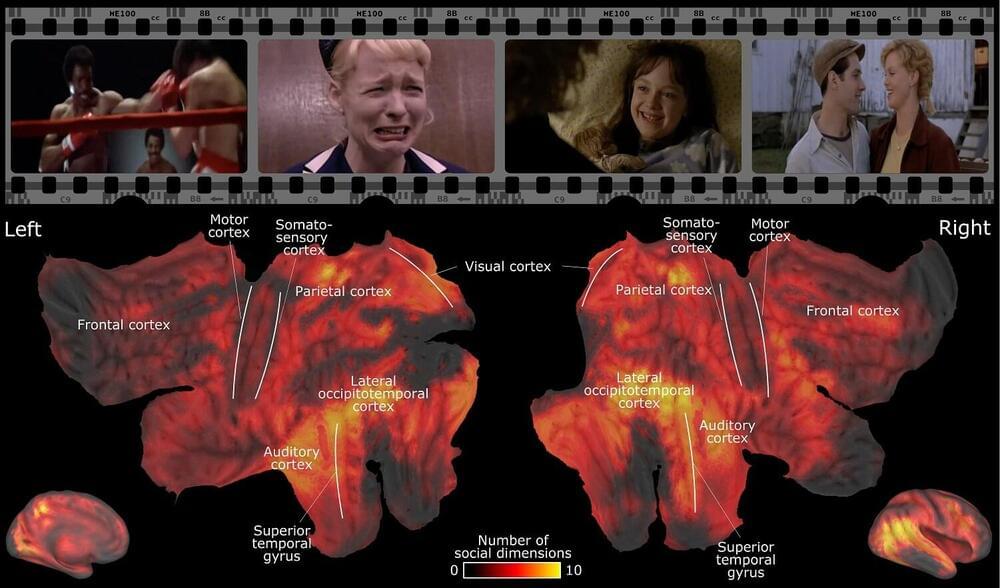Apr 20, 2023
Scientists engineer the first light-powered yeast
Posted by Shailesh Prasad in category: energy
Experiments show ease by which organisms can evolve the ability to harness sunlight for energy.
Experiments show ease by which organisms can evolve the ability to harness sunlight for energy.

https://youtube.com/watch?v=MlvjPQuLpvE
A recent study conducted at the University of Turku in Finland shows that different people have similar brain activity when perceiving social situations. Researchers discovered an extensive neural network in the human brain that effectively processes various social information.
Social interaction is central to all aspects of human life. Interaction requires the perception and interpretation of the social environment as well as flexible reacting to other people’s behavior. The human brain is capable of such perception and decision-making automatically and rapidly. However, the social information processing mechanisms of the brain remain unresolved.
A superfluid neutrino radio telescope could scan the entire universe in seconds.
A team including physicists of the University of Bern has for the first time detected subatomic particles called neutrinos created by a particle collider, namely at CERN’s Large Hadron Collider (LHC). The discovery promises to deepen scientists’ understanding of the nature of neutrinos, which are among the most abundant particles in the universe and key to the solution of the question why there is more matter than antimatter.
Neutrinos are fundamental particles that played an important role in the early phase of the universe. They are key to learn more about the fundamental laws of nature, including how particles acquire mass and why there is more matter than antimatter. Despite being among the most abundant particles in the universe they are very difficult to detect because they pass through matter with almost no interaction. They are therefore often called “ghost particles.”
Neutrinos have been known for several decades and were very important for establishing the standard model of particle physics. But most neutrinos studied by physicists so far have been low-energy neutrinos. Previously, no neutrino produced at a particle collider had ever been detected by an experiment. Now, an international team including researchers from the Laboratory for High Energy Physics (LHEP) of the University of Bern has succeeded in doing just that. Using the FASER particle detector at CERN in Geneva, the team was able to detect very high energy neutrinos produced by brand a new source: CERN’s Large Hadron Collider (LHC). The international FASER collaboration announced this result on March 19 at the MORIOND EW conference in La Thuile, Italy.
A team led by physicists from Oxford University analyzed data from the Large Hadron Collider (LHC) and discovered that a subatomic particle can switch between matter and antimatter, a report by New Atlas explained.
Antimatter, which is differentiated by having the opposite charge to normal matter, is composed of the antiparticles of normal matter. Some particles oscillate between being matter and antimatter via superposition, as illustrated by the thought experiment of Schrödinger’s cat.
In a world-first discovery, it was found that the charm meson, a subatomic particle made out of a charm quark and an antiquark, can travel as a mixture of their particle and antiparticle states, all the while spontaneously switching between the two. The finding is detailed on the preprint server arXiv.

When used at home, it might take care of your yard, and even your grandparents, as Musk suggests in his piece, Believing in technology for a better future, in the Cyberspace Administration of China’s publication:
Tesla Bots are initially positioned to replace people in repetitive, boring, and dangerous tasks. But the vision is for them to serve millions of households, such as cooking, mowing lawns, and caring for the elderly.
Continue reading “Tesla Robot: News, Rumors, and Estimated Price, Release Date, and Specs” »
DNA and self assembly of nanoparticles.
Dropbox is a free service that lets you bring your photos, docs, and videos anywhere and share them easily. Never email yourself a file again!
In the future, communications networks and computers will use information stored in objects governed by the microscopic laws of quantum mechanics. This capability can potentially underpin communication with greatly enhanced security and computers with unprecedented power. A vital component of these technologies will be memory devices capable of storing quantum information to be retrieved at will.
Virginia Lorenz, a professor of physics at the University of Illinois Urbana-Champaign, studies Lambda-type optical quantum memory devices, a promising technology that relies on light interacting with a large group of atoms. She is developing a device based on hot metallic vapor with graduate student Kai Shinbrough.
As the researchers work towards a practical device, they are also providing some of the first theoretical analyses of Lambda-type devices. Most recently, they reported the first variance-based sensitivity analysis describing the effects of experimental noise and imperfections in Physical Review A.
Ed Boyden shows how, by inserting genes for light-sensitive proteins into brain cells, he can selectively activate or de-activate specific neurons with fiber-optic implants. With this unprecedented level of control, he’s managed to cure mice of analogs of PTSD and certain forms of blindness. On the horizon: neural prosthetics. Session host Juan Enriquez leads a brief post-talk Q&A.
Year 2021 😗😁
Researchers say algorithms can simulate an infinite quantum system on finite quantum computers in interesting advance for quantum tech.
Scientists have recently identified a unique form of cell messaging occurring in the human brain that’s not been seen before.
Excitingly, the discovery hints that our brains might be even more powerful units of computation than we realized.
Back in 2020, researchers from institutes in Germany and Greece reported a mechanism in the brain’s outer cortical cells that produces a novel ‘graded’ signal all on its own, one that could provide individual neurons with another way to carry out their logical functions.
